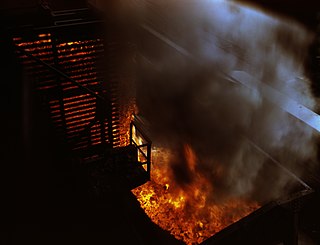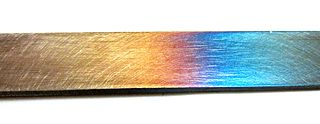
An alloy is a mixture of chemical elements of which at least one is a metal. Unlike chemical compounds with metallic bases, an alloy will retain all the properties of a metal in the resulting material, such as electrical conductivity, ductility, opacity, and luster, but may have properties that differ from those of the pure metals, such as increased strength or hardness. In some cases, an alloy may reduce the overall cost of the material while preserving important properties. In other cases, the mixture imparts synergistic properties to the constituent metal elements such as corrosion resistance or mechanical strength.

Steel is an alloy of iron and carbon with improved strength and fracture resistance compared to other forms of iron. Because of its high tensile strength and low cost, steel is one of the most commonly manufactured materials in the world. Steel is used in buildings, as concrete reinforcing rods, in bridges, infrastructure, tools, ships, trains, cars, bicycles, machines, electrical appliances, furniture, and weapons.

Stainless steel, also known as inox, corrosion-resistant steel (CRES) and rustless steel, is an alloy of iron that is resistant to rusting and corrosion. It contains iron with chromium and other elements such as molybdenum, carbon, nickel and nitrogen depending on its specific use and cost. Stainless steel's resistance to corrosion results from the 10.5%, or more, chromium content which forms a passive film that can protect the material and self-heal in the presence of oxygen.

Wrought iron is an iron alloy with a very low carbon content in contrast to that of cast iron. It is a semi-fused mass of iron with fibrous slag inclusions, which give it a wood-like "grain" that is visible when it is etched, rusted, or bent to failure. Wrought iron is tough, malleable, ductile, corrosion resistant, and easily forge welded, but is more difficult to weld electrically.

Cast iron is a class of iron–carbon alloys with a carbon content of more than 2% and silicon content around 1–3%. Its usefulness derives from its relatively low melting temperature. The alloying elements determine the form in which its carbon appears: white cast iron has its carbon combined into an iron carbide named cementite, which is very hard, but brittle, as it allows cracks to pass straight through; grey cast iron has graphite flakes which deflect a passing crack and initiate countless new cracks as the material breaks, and ductile cast iron has spherical graphite "nodules" which stop the crack from further progressing.

A blacksmith is a metalsmith who creates objects primarily from wrought iron or steel, but sometimes from other metals, by forging the metal, using tools to hammer, bend, and cut. Blacksmiths produce objects such as gates, grilles, railings, light fixtures, furniture, sculpture, tools, agricultural implements, decorative and religious items, cooking utensils, and weapons. There was an historical distinction between the heavy work of the blacksmith and the more delicate operation of a whitesmith, who usually worked in gold, silver, pewter, or the finishing steps of fine steel. The place where a blacksmith works is called variously a smithy, a forge or a blacksmith's shop.

An ironclad was a steam-propelled warship protected by steel or iron armor constructed from 1859 to the early 1890s. The ironclad was developed as a result of the vulnerability of wooden warships to explosive or incendiary shells. The first ironclad battleship, Gloire, was launched by the French Navy in November 1859, narrowly preempting the British Royal Navy. However, Britain built the first completely iron-hulled warships.

Carbon steel is a steel with carbon content from about 0.05 up to 2.1 percent by weight. The definition of carbon steel from the American Iron and Steel Institute (AISI) states:

In materials science, quenching is the rapid cooling of a workpiece in water, gas, oil, polymer, air, or other fluids to obtain certain material properties. A type of heat treating, quenching prevents undesired low-temperature processes, such as phase transformations, from occurring. It does this by reducing the window of time during which these undesired reactions are both thermodynamically favorable and kinetically accessible; for instance, quenching can reduce the crystal grain size of both metallic and plastic materials, increasing their hardness.

Carburizing, or carburising, is a heat treatment process in which iron or steel absorbs carbon while the metal is heated in the presence of a carbon-bearing material, such as charcoal or carbon monoxide. The intent is to make the metal harder and more wear resistant. Depending on the amount of time and temperature, the affected area can vary in carbon content. Longer carburizing times and higher temperatures typically increase the depth of carbon diffusion. When the iron or steel is cooled rapidly by quenching, the higher carbon content on the outer surface becomes hard due to the transformation from austenite to martensite, while the core remains soft and tough as a ferritic and/or pearlite microstructure.

Case-hardening or Carburization is the process of introducing carbon to the surface of a low carbon iron or much more commonly low carbon steel object in order to enable the surface to be hardened.

Tempering is a process of heat treating, which is used to increase the toughness of iron-based alloys. Tempering is usually performed after hardening, to reduce some of the excess hardness, and is done by heating the metal to some temperature below the critical point for a certain period of time, then allowing it to cool in still air. The exact temperature determines the amount of hardness removed, and depends on both the specific composition of the alloy and on the desired properties in the finished product. For instance, very hard tools are often tempered at low temperatures, while springs are tempered at much higher temperatures.

Hayward Augustus Harvey was an American inventor and industrialist.
Compound armour was a type of armour used on warships in the 1880s, developed in response to the emergence of armor-piercing shells and the continual need for reliable protection with the increasing size in naval ordnance. Compound armour was a non-alloyed attempt to combine the benefits of two different metals—the hardness of steel with the toughness of iron—that would stand up to intense and repeated punishment in battle. By the end of the decade it had been rendered obsolete by nickel-steel armour. However, the general principle of compound iron was used for case-hardened armour, which replaced nickel-steel in the mid-1890s and is still used today.

Krupp armour was a type of steel naval armour used in the construction of capital ships starting shortly before the end of the nineteenth century. It was developed by Germany's Krupp Arms Works in 1893 and quickly replaced Harvey armour as the primary method of protecting naval ships, before itself being supplanted by the improved Krupp cemented armour.

Iron armour was a type of naval armour used on warships and, to a limited degree, fortifications. The use of iron gave rise to the term ironclad as a reference to a ship 'clad' in iron. The earliest material available in sufficient quantities for armouring ships was iron, wrought or cast. While cast iron has never been used for naval armour, it did find a use in land fortifications, presumable due to the lower cost of the material. One well known example of cast-iron armour for land use is the Gruson turret, first tested by the Prussian government in 1868. Armoured ships may have been built as early as 1203, in the far east. In the West, they first become common when France launched the first ocean-going ironclad La Gloire in 1859. The British Navy responded with HMS Warrior in 1860, triggering a naval arms race with bigger, more heavily armed and armoured ironclads.

Austempering is heat treatment that is applied to ferrous metals, most notably steel and ductile iron. In steel it produces a bainite microstructure whereas in cast irons it produces a structure of acicular ferrite and high carbon, stabilized austenite known as ausferrite. It is primarily used to improve mechanical properties or reduce / eliminate distortion. Austempering is defined by both the process and the resultant microstructure. Typical austempering process parameters applied to an unsuitable material will not result in the formation of bainite or ausferrite and thus the final product will not be called austempered. Both microstructures may also be produced via other methods. For example, they may be produced as-cast or air cooled with the proper alloy content. These materials are also not referred to as austempered.

Structural engineering depends on the knowledge of materials and their properties, in order to understand how different materials resist and support loads.
Special treatment steel (STS), also known as protective deck plate, was a type of warship armor developed by Carnegie Steel around 1910.
Naval armor refers to the various protections schemes employed by warships. The first ironclad warship was created in 1859, and the pace of armour advancement accelerated quickly thereafter. The emergence of battleships around the turn of the 20th century saw ships become increasingly large and well armoured. Vast quantities of heavily armoured ships were used during the World Wars, and were crucial in the outcome. The emergence of guided missiles in the last part of the 20th century has greatly reduced the utility of armor, and most modern warships are now only lightly armored.
















